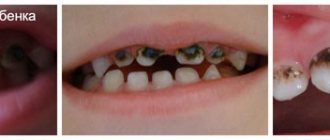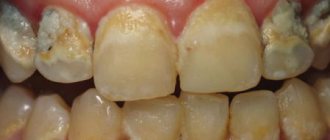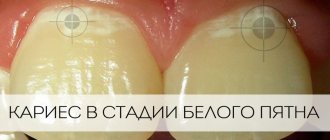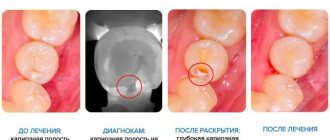Silvering of teeth is a method of treating mild caries. The procedure involves applying a silver solution to teeth affected by caries. To achieve a lasting positive effect, it is necessary to carry out silvering several times. The advantage of the procedure is that it is absolutely painless and does not require the use of a drill.
Silvering is used only in young children to treat caries of baby teeth. This limitation is due to the fact that silver gives teeth a dark color and makes them unattractive.
Prevention of caries in primary teeth. Silvering or fluoridation – which is better? Dentists answer
On baby teeth, the enamel is thinner, and the pulp chamber inside is wider and larger than in permanent teeth. Therefore, caries in children progresses at lightning speed. A small brown spot very quickly grows to the size of a full-fledged carious cavity, and the lesion spreads to the pulp - the neurovascular bundle. As a result, pulpitis develops, that is, inflammation of the nerve, and this inevitably entails many serious symptoms, including severe pain. To avoid such unfavorable developments, parents should closely monitor the condition of their child’s oral cavity. While caries is at the white spot stage, the situation can still be reversed, and prevention methods help with this - silvering or fluoridation of baby teeth. Read more about each method, its pros and cons, further in the article.
Fluoridation procedure
Fluoridation and silvering of teeth
The teeth are first cleaned and then chemicals are applied. In order to increase the efficiency of their penetration into the enamel layers, ultrasound, vacuum or electrophoresis are sometimes used. As a rule, it takes several weeks after the remineralization course for the teeth to regain their properties. The dentist may also prescribe a repeat course.
To keep your teeth healthy, it is extremely important to eat right (eat more vitamins and foods containing minerals), practice good hygiene, and use additional care products in addition to a traditional toothbrush. For example, one of the most effective means is an oral irrigator.
, which allows you to clean the oral cavity using a pressurized water jet.
Why is it so important to treat caries of baby teeth in a timely manner?
Caries is one of the most common dental pathologies, leading to the gradual destruction of hard tissues as a result of the rapid proliferation of bacteria and harmful microorganisms. There are quite a few possible prerequisites for the development of the disease: from a love of sweets and insufficient hygiene to improper formation of tooth buds even at the stage of intrauterine development of the fetus. In any case, the problem is serious and requires timely treatment, especially if we are talking about primary incisors with a thin enamel layer.
Some parents mistakenly believe that treating temporary teeth is not necessary. Expecting their rapid replacement, they lose sight of a very important point: the pathological process quickly destroys hard tissues, leads to their rotting and at the same time inevitably spreads to the rudiments of permanent elements. As a result, they erupt with problems. In addition, neglected caries turns into pulpitis, which sometimes leads to the need for premature removal of the causative tooth. In this case, there is a serious risk of developing jaw abnormalities, which will subsequently require long-term orthodontic treatment to eliminate.
If the problem is not treated, you can lose your teeth
The development of caries begins with the appearance of a small pretty spot on the enamel - at this stage there is still a chance to save the situation and prevent further spread of the pathological process. To do this, dentistry performs a silvering procedure or prescribes a course of fluoridation. To understand what is best to choose for a child, it is worth considering in detail the pros and cons of each method.
Advantages and disadvantages of fluoridation
| pros | Minuses |
|
|
Silvering - why is it done for children?
To stop the spread of the carious process, a silvering procedure is performed in pediatric dentistry. The causative tooth is covered with a thin protective film, using a special preparation with silver nitrate. This is an absolutely harmless composition that prevents the accumulation of soft bacterial plaque and effectively fights the proliferation of bacteria. The active ingredients are non-toxic and completely safe for children's bodies. The procedure itself can be described by the following characteristics:
- the whole process takes about 5 minutes,
- the child does not experience pain or discomfort,
- the drug applied to the enamel effectively stops the pathological process at the initial stage of its development, thereby preventing further destruction of hard tissues,
- the composition is completely safe for the enamel and the health of the child in general,
- Silvering is an inexpensive service that is offered in all public and some private dental clinics.
The photo shows teeth after the silvering procedure.
The procedure, although harmless, is far from harmless in terms of aesthetics. The fact is that after applying the composition to the enamel, the affected areas noticeably darken and even turn black - it is impossible to bleach them, so you just have to wait until the stage of changing the bite begins. Another point: the method is effective for the front incisors and canines, but this product is not used for treating the chewing surfaces of molars.
Is it possible to silver teeth at home?
The procedure for plating baby teeth with silver is simple and only takes a few minutes. So maybe it’s worth doing it at home, especially when the child is afraid to even go into the dentist’s office?
The answer to this question is a categorical no! It is impossible to carry out such a manipulation, although simple, outside a medical institution, since preparations based on silver fluoride diamine are absolutely safe, but they can still cause an uncontrollable allergic reaction in the child.
Without special knowledge and tools, parents cannot independently determine the depth of the lesion. And if dentin is damaged, the procedure will not only have no beneficial effect, but will also provoke the death of the pulp.
In addition, insufficiently thorough cleaning of the tooth surface will lead to plaque turning black, which will be almost impossible to remove.
How is the procedure performed and is it necessary?
The specialist moistens a cotton swab in a special liquid, and then runs it over the surface of the enamel several times. After the procedure, you should not rinse your mouth, drink or eat food for 40 minutes. This time is enough for a protective film to form on the teeth. Subsequently it will be impossible to remove it. One of the significant disadvantages of the method is the obvious blackening of hard tissues, but only areas already affected by the carious process darken.
The antibacterial coating prevents the further spread of pathology. This is a good option to protect temporary teeth until they are replaced with permanent ones. The method is used only in pediatric dentistry, for children under 3 years of age. True, the protective layer is quickly destroyed under the aggressive influence of acids found in many foods and drinks. Therefore, the procedure is usually carried out in courses - from 3 to 5 sessions at intervals of one day. After six months, it is recommended to repeat the course.
During the procedure, a special composition is applied to the patient’s teeth.
“My daughter had severe enamel hypoplasia, and her teeth were very problematic. Nobody ever told me what the reason was. They say the problem may be genetic or just a congenital anomaly. In general, one private clinic insisted on silver plating. We agreed. But in vain... Not only did the teeth turn black, but they continued to deteriorate. And already at the state clinic, the doctor, a very smart woman, explained to us that in our advanced case, silvering was unacceptable! It is carried out only in the very early stages or for prevention. In serious cases, the composition may get on the pulp, and this will lead to its gradual death. That’s what happened to us!”
NinaM., from correspondence on the woman.ru forum
The procedure has a number of contraindications, in particular a tendency to allergic reactions to the components included in the drug, serious somatic diseases, advanced caries and dentin pathologies. Many experts in the field of pediatric dentistry recommend this procedure as a preventive measure for tooth decay, but it will only be effective in the early stages. If the lesion is regarded as medium or deep, silvering loses all meaning, and the procedure itself even becomes dangerous. If the composition gets on the pulp, it can lead to its inflammation and death.
Alternative options
Modern dentistry can offer not only silvering of teeth or fluoridation. There are other options for strengthening enamel, preventing and treating caries in children.
- Fissure sealing. During the procedure, chewing molars and premolars are exposed to special compounds. The doctor closes the existing fissures (natural depressions) with sealants that prevent the destructive action of bacteria. You can read more about the technology in the article on the website.
- Remineralization of enamel. Doctors apply products containing calcium, phosphorus, magnesium and other useful components to hard tissues. Remotherapy can be periodically carried out at home using special foams, bioactive pastes and gels for children containing calcium hydroxyapatite and phosphates. For example, REMARS JUNIOR, Apadent Kids, Splat, Junior, Tooth Mousse.
- Ozonation. During the procedure, the doctor treats hard tissues with ozone, which has a pronounced antibacterial effect. This technology may well compete with other methods if you need to stop the development of initial caries or need to prevent dental diseases.
In cases where the tooth has nevertheless undergone severe destruction, doctors treat caries using boron, then place a photopolymer filling, which, by the way, can be colored. If it is necessary to remove a diseased milk element long before the appearance of a permanent one, it is important to carry out prosthetics with temporary crowns or removable structures so that the adjacent elements of the row do not begin to shift to the place of the lost one and a malocclusion does not occur.
Fluoridation is a modern alternative to silver plating
Today, the silvering method is slowly moving aside, giving way to more modern and effective methods of caries prevention. After the procedure, the teeth become very black, which can provoke psychological complexes in the child. In addition, the technique is effective only in relation to incisors and canines and can only help in the very early stages of the development of the disease. With deeper lesions, silvering can provoke pulp damage. Therefore, parents of young patients increasingly prefer a more modern alternative - fluoridation.
The photo shows fluoridation of a child's teeth
When answering the question of what is the fundamental difference between the methods, you should immediately notice an important detail: fluoridation provides nutrition and saturation of tissues with useful minerals, but does not lead to their darkening. A special preparation with fluorine, phosphorus and copper is carefully applied to the surface of the enamel. The active components penetrate into the deep layers of hard tissue and literally “seal” microcracks, thereby stopping the further development of the pathological process.
Important! In some regions of Russia, the concentration of fluoride in water supplies greatly exceeds the permissible limit. Ideally, the indicator should vary from 0.7 to 1.2 mg/l. If in your region the concentration exceeds the maximum threshold, it is better to avoid fluoridation, as well as to avoid using hygiene products with a high content of this substance.
But there is another way, for example, the composition can be applied by applying it to the inner surface of special mouth guards. The child puts them on his teeth and wears them for the time recommended by the doctor. The course usually lasts about 10 days. There is also the option of fluoridation using electrophoresis and a deep technique. The latter provides reliable protection against caries for up to a year. First, the specialist applies a solution with fluorinated calcium and magnesium. After it dries, the enamel is treated with copper and calcium hydroxide. This approach provides additional tissue remineralization and helps stop the spread of carious lesions1.
Advantages and disadvantages of methods
What is better: silvering or fluoridation of children's teeth? Each method has its own advantages and disadvantages. Let's look at them in more detail in the tables below.
Advantages and disadvantages of silvering
| pros | Minuses |
|
|
Silvering or fluoridation – which is better for the child?
The main difference is the composition used. If during silvering the affected areas darken irrevocably, then after fluoridation such troubles cannot be expected. Regarding the question of which is more reliable, the efficiency will be approximately at the same level. Both methods are powerless for medium and deep caries.
But the cost of silver will be lower. The average price for treating one tooth starts from 50 rubles. At the same time, the procedure can be performed free of charge in a municipal clinic. The cost of fluoridation largely depends on the chosen method, but usually it is slightly higher than the price of treating incisors with silver ions - from 200 to 300 rubles per tooth.
The main difference between silver plating and fluoridation is the aesthetic side
As a rule, the aesthetic defect from silvering becomes a decisive factor when choosing a method. Treatment of enamel with fluoride does not affect the appearance of the smile in any way and at the same time provides protection no worse than silver ions. It is important to understand that these are not methods of treating caries, but methods of prevention that help stop the further spread of pathology while it is in the very beginnings of its development.
Tips and tricks for parents
- If you are not sure about the correct choice regarding silvering of teeth, then it is better to give preference to fluoridation or remineralization.
- If you find gray spots on your child’s teeth, you should consult a specialist. He will conduct an examination and make recommendations regarding the prevention of caries.
- If white spots appear on baby teeth, the doctor will most likely recommend using toothpastes with fluoride. Usually this measure is enough to prevent the development of the disease.
- If caries has affected only the tooth enamel, then it will be enough to perform fluoridation or remineralization. Silvering in this case is inferior to the first two methods of prevention.
- With average caries, silvering will help delay the development of pulpitis. However, it is better to carry out full treatment and put a filling.
- Regardless of the choice of technique, it is worth remembering that after the procedure it is necessary to provide the child with proper hygiene and teach him how to brush his teeth correctly.
- The baby's diet should be balanced. It is necessary to provide the child with foods containing calcium, fluorine, phosphorus, magnesium and other microelements. In childhood, the structure of the dental enamel of permanent units is formed.
How to protect baby teeth – what else does dentistry offer?
In addition to the preventive methods described above, modern pediatric dentistry offers other options for caries prevention. Here are some popular options:
- ozonation – treatment of hard tissues with ozone, including root canals. The procedure helps stop the development of carious processes - ozone effectively kills pathogenic microflora,
- fissure sealing – the recesses on the chewing surface of the molars are filled with a special sealant to protect the tissues from the effects of pathogenic microorganisms and saturate them with mineral ions. The method is both therapeutic and preventive,
- filling – is carried out for moderate and advanced caries, when there is already a dark spot on the tooth, even if it is very small. The doctor removes the affected tissue, carries out antiseptic treatment and fills the defect using photopolymers,
- prosthetics - if the destruction is large-scale, pulpitis is diagnosed and there is no chance of saving the tooth, it is necessary to carry out extraction with mandatory subsequent prosthetics with a temporary crown (if there is more than a year before the bite change). Otherwise, the dental system may not form correctly, and this can lead to curvature of the bite and permanent teeth.
The photo shows prosthetics for baby teeth
Each method is effective for specific clinical cases. The choice should be made based on the recommendations of a specialist, taking into account the individual characteristics of the clinical picture and the health of the child as a whole.
- Kuzina HA, Berezhnoy V.P. Application of deep fluoridation in practice, 2001.
Which is better: expert opinion and patient reviews
Some experts believe that it is important to take into account not only the clinical situation, but the age of the child and his psychological characteristics. Thus, silvering can be carried out on the youngest children, and fluoridation can only be carried out on those who have already reached 2 years of age. It also matters how much the child’s parents are willing to spend on treatment, because fluoridation costs several times more. Other doctors reject silvering and advocate more modern techniques.
“Silvering of teeth is an outdated, but still popular in Russia, method of strengthening baby teeth. But fluoridation is a modern and best technology in terms of aesthetics and quality, which is applicable not only for milk teeth, but also for permanent teeth in children and adults. Fluoridation today is carried out not only for the purpose of preventing and treating initial forms of caries, but also to strengthen the enamel before and after whitening, in preparation for prosthetics,” explains Tatyana Vitalievna Varlamova, dentist-therapist.
“Silver acts only as a short-acting antiseptic, but it is not able to rid teeth of caries. Moreover, after coloring them, parents often miss the destructive process that continues after a short period of time, since it remains “camouflaged.” It is because of these shortcomings that I consider the procedure ineffective and do not prescribe it to my patients. If the doctor offers you only silvering, then it means that he does not know modern techniques at all. Today there are more worthy alternatives, and not only fluoridation, but treatment using the Icon method, remineralization,” says A.N. Krasnenko, pediatric dentist.
As for patients, what is becoming increasingly important to them is not so much the cost of the technique, but the aesthetic aspect. Many parents admit that modern children grow up very quickly, and therefore begin to experience difficulties in communicating with peers if they have teeth black with silver.
“I have two children with an age difference of 10 years. So, the eldest was silver plated as a child, since other methods were not common in Russia at that time. Then this blackness on the teeth caused us a lot of trouble: we went to school, but the bite did not change, and my daughter had a very bad complex in front of her peers, she was teased. I had to say that she has precious teeth, while everyone else has ordinary teeth. But with my youngest, when we went to the dentist about white spots on our teeth, we were already offered not only this method, but also fluoridation. I immediately agreed to the alternative, and my child grew up calmly, without embarrassment about his appearance! But the therapeutic effect of these technologies, I believe, is approximately the same!”
Svetlana_78, review from 32top.ru
Silvering at home and alternative methods
Despite the fact that the process takes a little time, silvering at home is strictly prohibited. If a child has an undetected allergy to silver fluoride diamine, parents simply will not have time to help the child. In addition, mothers and fathers will not be able to independently determine the depth of damage to dentin, and in case of serious illness, silvering will only provoke the rapid development of caries. And the last argument is that it is impossible to clean your teeth from plaque efficiently at home, even if you take the hardest brush. As a result, the black plaque will remain with the child until the tooth falls out.
As an alternative to silvering, the following are used:
- Fluoridation or remineralization. This is a procedure for treating enamel with fluoride preparations. As a result, a dense protective film is formed on the surface of the tooth, which blocks the development of microbes. It is recommended to carry out the procedure at the age of 3-4 years.
- Ozonation. Ozone is a powerful antimicrobial agent, so ozonation of teeth is also considered to prevent caries.
The decision about the effectiveness of a particular process is made only by a specialist, based on the individual characteristics of the patient.











